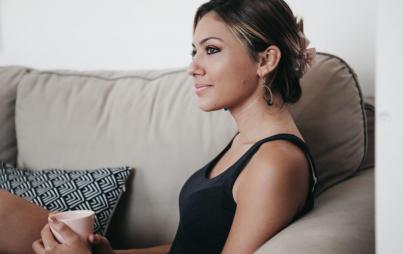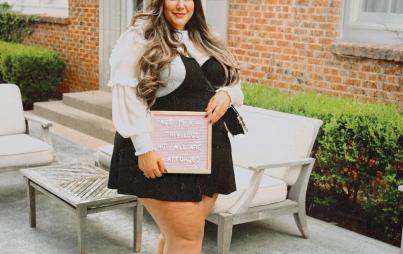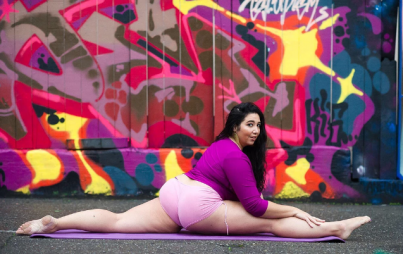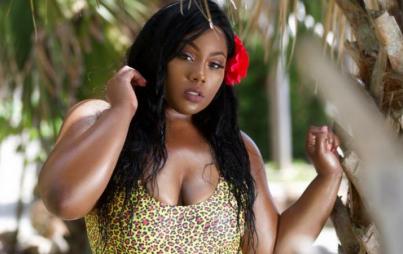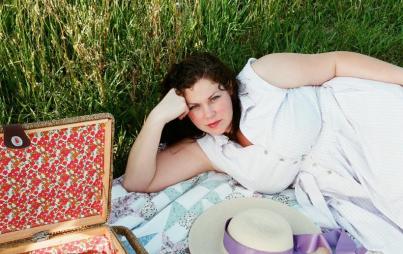
I ask myself these questions every time I’m considering a purchase, and if the answer to any of them is “no,” I put it back on the rack. Next time you hit the mall, see how your answers to these questions change your shopping habits.
Capsule wardrobes and minimalism are all the rage right now, which is great. It’s awesome to see people being more thoughtful about their shopping and clothing choices, and if a capsule wardrobe craze is the catalyst for that, then I’m all for it. But it’s also good to remember that you don’t have to commit to strict shopping bans or garment limits to shop more mindfully and create an effective, pared-down wardrobe that works for you. There’s a middle ground here, too!
I used to be a compulsive shopper, with an overstuffed closet and a perpetually dwindling bank account balance. When my boyfriend and I moved across the country, I gave away nearly all of my clothes (we brought only what we could fit in our tiny car), and it ended up being the perfect fresh start I needed to reassess my shopping habits and my personal style. I wanted to be thoughtful about the clothes I bought to fill in the gaps in my wardrobe. I’m not organized enough to commit to a capsule wardrobe, and I tend to get rebellious in the face of limits (even self-imposed ones), so I decided to focus on a more intuitive way to change my habits: being a more thoughtful shopper. No more impulse buys. No more making deals with myself to justify buying things I can’t afford. No more shopping as a band-aid for emotional issues that deserve much deeper reflection than a frantic trip to Nordstrom.
As I learned to shop in a more mindful way, I started asking myself a series of questions that help guide my buying decisions. I ask myself these questions every time I’m considering a purchase, and if the answer to any of them is “no,” I put it back on the rack. Next time you hit the mall, see how your answers to these questions change your shopping habits:
1. Does it fill a hole in your wardrobe?
First and foremost — is this an item you actually need? Most of us have a few garments we buy over and over again in slightly different iterations. For my friend Lauren, it’s flowy white blouses. For me, it’s black jersey dresses. My mom can buy a printed knee-length skirt every day and still yearn for more. And while it’s great to have certain signature items that form the backbone of your wardrobe, these items can easily become bad shopping habits. We buy more and more of them because they’re easy and fun to buy, not because we actually need them. Before buying something, ask yourself: is this something I actually need, or is it an unnecessary replica of something I already have?
2. Can you incorporate it into at least two outfits with items you already own?
This is another must for creating a cohesive wardrobe: considering how your new garment will pair with things you already own. In the dressing room, take a second to see if you can come up with two different ways to incorporate the item into your current wardrobe. If you can’t come up with two outfits off the top of your head, chances are this item won’t get worn often enough to justify the purchase.
3. Does it feel good on your body?
One of the best shopping changes I’ve made in the past couple of years has been to only buy clothes that feel good on my body. I used to buy tons of cheap, trendy clothes made of polyester that felt like scratchy plastic against my skin. No matter how on-trend these garments were, or how good they looked from the outside, they didn’t feel good. This meant that they didn’t get worn often, and when I did wear them, I felt awkward and uncomfortable. These days I gravitate toward cotton, rayon, jersey, cashmere, and other fabrics that feel soft and comfortable against my skin. I never regret buying something that feels good to put on.
4. Does it fit your body right now?
It should be a given that you only buy clothes that fit, but many of us have perfected a complicated game of negotiations that we play with ourselves every time we hit the dressing room. “These will be my goal jeans!” we say to ourselves as we struggle with the zipper. Make a vow to stop buying clothes that don’t fit your body exactly as it is right now. Not as it will be in six months, and not as it might be after your next juice cleanse. Shop for your current body. Honor your current body. Treat it well and dress it well. And if it does change in the future, adjust your wardrobe accordingly.
5. Does it fit your life right now?
I struggle with this one a lot, because it’s very hard for me to admit to myself that as a freelance writer who works from home, I might not actually need a huge collection of sequined platform pumps and embellished kimono dresses (note to self: consider becoming rock star or Vegas cocktail waitress instead). But the key to having a practical, streamlined wardrobe is being honest with yourself about where you’re at and what you need. That means, for me, a focus on comfortable jeans, knit tops, and leggings that make sense for my home office life. It means a few cute dresses for going out with friends, a couple yoga outfits, and I’m good to go. It’s tempting to put on a certain piece of clothing and think, “I wouldn’t wear this tie-dye maxi dress now, but maybe if I buy it, I’ll become the kind of person who goes to music festivals.” That is a trap that results in a closet full of unworn clothes tailored for a life you don’t live. Shop for your real life, right now. Not the future or the past or the “maybe someday.”
6. Does it make you want to do a happy dance in the dressing room?
This is my favorite question. Honestly, sometimes I skip all the others and go straight to this one. There’s a huge difference between clothes that make you feel “meh” and clothes that make you feel fabulous and stylish and excited — and that difference is usually evident the moment you put something on in the dressing room. Your wardrobe and your shopping habits will change dramatically when you make a decision to stop buying things that make you feel “meh.” This means not buying as many clothes; in fact, it might mean not buying any clothes for a while, period. But trust me, holding out for those truly special garments is key to building a wardrobe that you really love (and that loves you back). When you put something on, if you don’t want to dance around in front of the mirror and ask the store clerk if she can cut off the tags so you can wear it home, take a pass. Those dance-worthy clothes are worth the wait.



